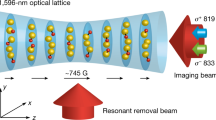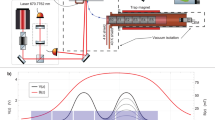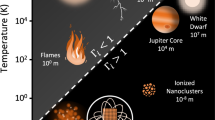Abstract
The study of cold and controlled molecular ions has been of key importance for a wide range of applications, such as the production of cold antihydrogen, creation and study of anionic Coulomb crystals and in atmospheric research and astrochemistry. However, the commonly used anion cooling technique via collisions with a buffer gas is limited by the temperature of the used cryogenic cooling medium. Here we demonstrate the forced evaporative cooling of anions via a laser beam with photon energies far above the photodetachment threshold of the anion. We cool an anionic ensemble from an initial temperature of 370(12) K down to 2.2(8) K. This results in a three orders of magnitude increase in the phase-space density of the ions, approaching the near-strong Coulomb coupling regime. We present an analysis of the cooling dynamics through a thermodynamic model that includes the role of intrinsic collisional heating, without any fitting parameters. This technique can be used to cool any anionic species below liquid helium temperature, providing a tool to push the frontiers of anion cooling below state-of-the-art temperature regimes.
This is a preview of subscription content, access via your institution
Access options
Access Nature and 54 other Nature Portfolio journals
Get Nature+, our best-value online-access subscription
$29.99 / 30 days
cancel any time
Subscribe to this journal
Receive 12 print issues and online access
$209.00 per year
only $17.42 per issue
Buy this article
- Purchase on Springer Link
- Instant access to full article PDF
Prices may be subject to local taxes which are calculated during checkout


Similar content being viewed by others
Data availability
The data that support the findings of this study are available from the corresponding author upon request. Source data are provided with this paper.
Code availability
The codes and analysis files that support the findings of this study are available from the corresponding author upon request.
References
Tomza, M. et al. Cold hybrid ion-atom systems. Rev. Mod. Phys. 91, 035001 (2019).
Puri, P. et al. Synthesis of mixed hypermetallic oxide BaOCa+ from laser-cooled reagents in an atom-ion hybrid trap. Science 357, 1370–1375 (2017).
Hall, F. H. J. & Willitsch, S. Millikelvin reactive collisions between sympathetically cooled molecular ions and laser-cooled atoms in an ion-atom hybrid trap. Phys. Rev. Lett. 109, 233202 (2012).
Germann, M., Tong, X. & Willitsch, S. Observation of electric-dipole-forbidden infrared transitions in cold molecular ions. Nat. Phys. 10, 820–824 (2014).
Kilaj, A. et al. Observation of different reactivities of para and ortho-water towards trapped diazenylium ions. Nat. Commun. 9, 2096 (2018).
Härter, A. et al. Population distribution of product states following three-body recombination in an ultracold atomic gas. Nat. Phys. 9, 512–517 (2013).
Wolf, J. et al. State-to-state chemistry for three-body recombination in an ultracold rubidium gas. Science 358, 921–924 (2017).
Puri, P. et al. Reaction blockading in a reaction between an excited atom and a charged molecule at low collision energy. Nat. Chem. 11, 615–621 (2019).
Hudson, E. R. Sympathetic cooling of molecular ions with ultracold atoms. EPJ Techn. Instrum. 3, 8 (2016).
Willitsch, S. Coulomb-crystallised molecular ions in traps: methods, applications, prospects. Int. Rev. Phys. Chem. 31, 175–199 (2012).
Rellergert, W. G. et al. Evidence for sympathetic vibrational cooling of translationally cold molecules. Nature 495, 490–494 (2013).
Stoecklin, T. et al. Explanation of efficient quenching of molecular ion vibrational motion by ultracold atoms. Nat. Commun. 7, 11234 (2016).
Hauser, D. et al. Rotational state-changing cold collisions of hydroxyl ions with helium. Nat. Phys. 11, 467–470 (2015).
McCarthy, M. C., Gottlieb, C. A., Gupta, H. & Thaddeus, P. Laboratory and astronomical identification of the negative molecular ion C6H−. Astrophys. J. 652, L141–L144 (2006).
Herbst, E. Can negative molecular ions be detected in dense interstellar clouds? Nature 289, 656–657 (1981).
Bastian, B., Michaelsen, T., Meyer, J. & Wester, R. Anionic carbon chain growth in reactions of \({\mathrm{C}}_{2}^{-}\), \({\mathrm{C}}_{4}^{-}\), \({\mathrm{C}}_{6}^{-}\), C2H−,C4H−, and C6H− with C2H2. Astrophys. J. 878, 162 (2019).
Kreckel, H. et al. Experimental results for H2 formation from H− and H and implications for first star formation. Science 329, 69–71 (2010).
Gerlich, D. et al. Ion trap studies of H− + H → H2 + e− between 10 and 135 K. Astrophys. J. 749, 22 (2012).
Otto, R., Mikosch, J., Trippel, S., Weidemüller, M. & Wester, R. Nonstandard behavior of a negative ion reaction at very low temperatures. Phys. Rev. Lett. 101, 063201 (2008).
Gianturco, F. A., Yurtsever, E., Satta, M. & Wester, R. Modeling ionic reactions at interstellar temperatures: the case of \({\mathrm{NH}}_{2}^{-}\) + H2 ⇔ NH3 + H−. J. Phys. Chem. A 123, 9905–9918 (2019).
Yzombard, P., Hamamda, M., Gerber, S., Doser, M. & Comparat, D. Laser cooling of molecular anions. Phys. Rev. Lett. 114, 213001 (2015).
Jordan, E., Cerchiari, G., Fritzsche, S. & Kellerbauer, A. High-resolution spectroscopy on the laser-cooling candidate La−. Phys. Rev. Lett. 115, 113001 (2015).
Gerber, S., Fesel, J., Doser, M. & Comparat, D. Photodetachment and Doppler laser cooling of anionic molecules. New J. Phys. 20, 023024 (2018).
Wan, M.-j, Huang, D.-h, Yu, Y. & Zhang, Y.-g Laser cooling of the OH– molecular anion in a theoretical investigation. Phys. Chem. Chem. Phys. 19, 27360–27367 (2017).
Crubellier, A. Theory of laser evaporative cooling of trapped negative ions. I. Harmonically bound ions and RF traps. J. Phys. B: At. Mol. Opt. Phys. 23, 3585–3607 (1990).
Cerchiari, G., Yzombard, P. & Kellerbauer, A. Laser-assisted evaporative cooling of anions. Phys. Rev. Lett. 123, 103201 (2019).
Andresen, G. B. et al. Evaporative cooling of antiprotons to cryogenic temperatures. Phys. Rev. Lett. 105, 013003 (2010).
Nötzold, M. et al. Thermometry in a multipole ion trap. Appl. Sci. 10, 5264 (2020).
Hlavenka, P. et al. Absolute photodetachment cross section measurements of the O− and OH− anion. J. Chem. Phys. 130, 061105 (2009).
Spitzer, L. Physics of Fully Ionized Gases 2nd edn (Interscience Publication, 1967).
Ichimaru, S. & Tanaka, S. Generalized viscoelastic theory of the glass transition for strongly coupled, classical, one-component plasmas. Phys. Rev. Lett. 56, 2815–2818 (1986).
Gilbert, S. L., Bollinger, J. J. & Wineland, D. J. Shell-structure phase of magnetically confined strongly coupled plasmas. Phys. Rev. Lett. 60, 2022–2025 (1988).
Davis, K. B., Mewes, M. O. & Ketterle, W. An analytical model for evaporative cooling of atoms. Appl. Phys. B: Lasers Opt. 60, 155–159 (1995).
Lauderdale, J. G., McCurdy, C. W. & Hazi, A. U. Conversion of bound states to resonances with changing internuclear distance in molecular anions. J. Chem. Phys. 79, 2200–2205 (1983).
Sanche, L. Low-energy electron scattering from molecules on surfaces. J. Phys. B: At. Mol. Opt. Phys. 23, 1597–1624 (1990).
Engel, F. et al. Precision spectroscopy of negative-ion resonances in ultralong-range Rydberg molecules. Phys. Rev. Lett. 123, 073003 (2019).
Weckesser, P. et al. Observation of Feshbach resonances between a single ion and ultracold atoms. Nature 600, 429–433 (2021).
Kas, M., Loreau, J., Liévin, J. & Vaeck, N. Reactivity of hydrated hydroxide anion clusters with H and Rb: an ab initio study. J. Phys. Chem. A 123, 8893–8906 (2019).
Hassan, S. Z. et al. Associative detachment in anion-atom reactions involving a dipole-bound electron. Nat. Commun. 13, 818 (2022).
Hassan, S. Z. et al. Quantum state-dependent anion-neutral detachment processes. J. Chem. Phys. 156, 094304 (2022).
Trippel, S. et al. Photodetachment of cold OH– in a multipole ion trap. Phys. Rev. Lett. 97, 193003 (2006).
Smith, J. R., Kim, J. B. & Lineberger, W. C. High-resolution threshold photodetachment spectroscopy of OH−. Phys. Rev. A 55, 2036–2043 (1997).
Acknowledgements
This work is supported by the Deutsche Forschungsgemeinschaft (DFG) under project no. WE/2661/14-1 and the Austrian Science Fund (FWF) through project no. I3159-N36. M.W. acknowledges support from the DFG (German Research Foundation) under Germany’s Excellence Strategy EXC2181/1-390900948 (the Heidelberg STRUCTURES Excellence Cluster).
Author information
Authors and Affiliations
Contributions
J.T. and S.Z.H. performed the experiments and data analysis. J.T. simulated the thermodynamical model. M.N. provided the simulations on temperature determination. E.S.E., R.W. and M.W. conceptualized the experiments. J.T. and S.Z.H. wrote the initial draft. All the authors edited and contributed in the preparation of the final manuscript.
Corresponding author
Ethics declarations
Competing interests
The authors declare no competing interests.
Peer review
Peer review information
Nature Physics thanks Daniel Comparat and the other, anonymous, reviewer(s) for their contribution to the peer review of this work.
Additional information
Publisher’s note Springer Nature remains neutral with regard to jurisdictional claims in published maps and institutional affiliations.
Supplementary information
Supplementary Information
Supplementary Sections I–III, Figs. 1–3 and Table 1.
Supplementary Data 1
Source data for Supplementary Fig. 1.
Supplementary Data 2
Source data for Supplementary Fig. 2.
Source data
Source Data Fig. 1
Source data for Fig. 1.
Source Data Fig. 2
Source data for Fig. 2.
Rights and permissions
Springer Nature or its licensor (e.g. a society or other partner) holds exclusive rights to this article under a publishing agreement with the author(s) or other rightsholder(s); author self-archiving of the accepted manuscript version of this article is solely governed by the terms of such publishing agreement and applicable law.
About this article
Cite this article
Tauch, J., Hassan, S.Z., Nötzold, M. et al. Laser-induced forced evaporative cooling of molecular anions below 4 K. Nat. Phys. 19, 1270–1274 (2023). https://doi.org/10.1038/s41567-023-02084-6
Received:
Accepted:
Published:
Issue Date:
DOI: https://doi.org/10.1038/s41567-023-02084-6
This article is cited by
-
Super-cooling lasers could help to reveal celestial chemistry
Nature (2023)
-
Anions get cold
Nature Physics (2023)



